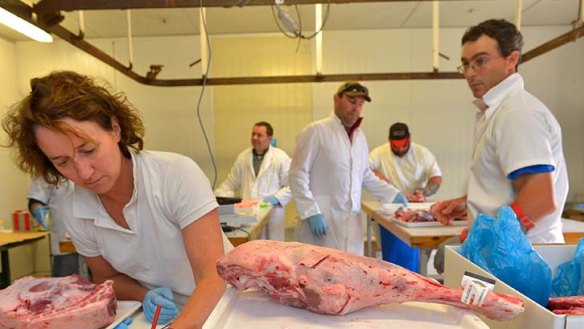Lambs to slaughter in pursuit of top chop

The table has been set carefully, although cutlery and dinner plates are nowhere to be seen. A large leg of lamb sits at one end, a lamb shoulder at the other - in between is a belly flap and other pieces of juicy red meat.
A single pesky fly has infiltrated the room and sits atop the belly flap, refusing to budge. But the presence of the lone intruder is not a problem, for this fresh lamb - slaughtered 48 hours ago - is not destined for the dinner plate.
These cuts of meat are instead about to be examined by a piece of valuable medical equipment that will X-ray them to determine how much of each piece is fat, meat and bone. In the process, the fly will be swatted - by a lengthy dose of radiation.
The table and the meat on top of it will be lifted up and down, moved forwards and backwards as it is scanned for about four minutes in a room at a Victorian Department of Environment and Primary Industries research farm in Hamilton, west of Melbourne.
Behind the yellow safety line, senior research scientist Ralph Behrendt sits at a computer terminal, operating the machine.
The X-rays are part of a two-year project investigating the impact of lamb diet and genetics on factors like lean meat yield from a carcass, quality, and lamb survival after birth.
Researchers are aiming to preserve the high quality taste of lamb, while also increasing the lean meat that can be obtained.
Such benefits would spread across the industry, especially for farmers who could produce more lean meat per animal, and for abattoirs, which could gain productivity.
Dr Behrendt says high lean meat-yielding carcasses are more valuable than others.
''What we're interested in is how tender the meat is, how much meat we can yield off the sale-able carcass, which then translates to the cuts that people see on the shelf. And how much fat there is, how much intra-muscular fat there is, because that influences eating quality,'' he says. ''The aim is to try and manage the amount of fat that's there, but not get rid of it entirely.''
The research farm is a hive of activity. Scores of young lambs graze in a feedlot while carcasses are scanned nearby. A short drive away at the research centre headquarters a team of people are ''boning out'' carcasses, separating out the meat, bone and fat, and taking out small samples from muscles.
To determine the impact of diet on lean meat yields, lambs in the study were separated into three different groups. One was fed a high energy and high protein diet, one a high energy and moderate protein diet and the other a moderate energy and high protein diet.
The $1.1 million project is jointly funded by the department and Meat and Livestock Australia. Victorian Agriculture Minister Peter Walsh says the study will deliver a range of benefits including higher meat yields, better breeding decisions, more consistency in meat quality for consumers and more productive and profitable farms.
Restaurant reviews, news and the hottest openings served to your inbox.
Sign up